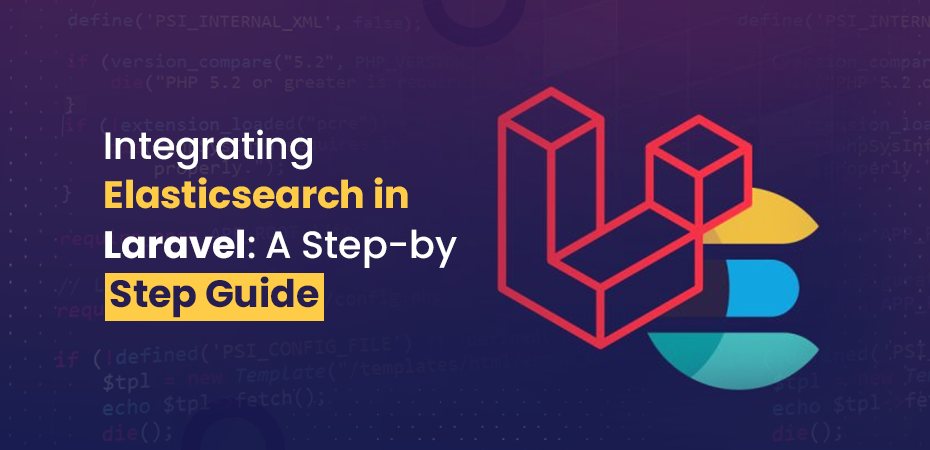Integrating Elasticsearch in Laravel: A Step-by-Step Guide

Integrating Elasticsearch with Laravel can significantly enhance your web application’s search capabilities. Elasticsearch.elasticsearch is a powerful, open-source search and analytics engine known for its speed and scalability. On the other hand, Laravel is a popular PHP framework that simplifies web development through its elegant syntax and robust features.
Here, in this blog, you will learn how to use elastic search in Laravel.
Why Integrate Elasticsearch in Laravel?
Here are a few reasons why you should consider integrating Elasticsearch into your Laravel application:
- Enhanced Search Capabilities: Elasticsearch allows you to implement advanced search functionalities such as full-text search, autocomplete, and filtering.
- SEO Optimization: Efficient search results improve user experience, which can positively impact your website’s SEO performance.
- Scalability: As your application grows, Elasticsearch ensures that your search operations remain fast and efficient.
What You Will Learn?
In this tutorial, we will cover the following topics:
- Setting up a new Laravel project.
- Installing and configuring the Elasticsearch PHP client.
- Testing the connection to your Elasticsearch server.
- Setting up database schemas using migrations.
- Indexing data from your database into Elasticsearch.
- Implementing advanced search functionalities such as autocomplete.
By the end of this tutorial, you’ll have a seamless integration of Elasticsearch within your Laravel application, ready to deliver powerful search capabilities.
Setting Up Your Laravel Project
Steps to Create a New Laravel Project
To kickstart your journey into integrating Elasticsearch with Laravel, you need to create a new Laravel project. Begin by opening your terminal and running the following command:
bash laravel new laravelelastic
This command will generate a fresh Laravel application named laravelelastic. Ensure you have Composer installed on your machine since it’s required to install Laravel.
Initial Setup and Configuration Details
Once your new Laravel project is created, navigate into the project directory:
bash cd laravelelastic
Here are some initial setup steps to get your application ready:
- Environment Configuration: Rename the .env.example file to .env and update the necessary environment variables, such as database credentials.
- Application Key: Generate an application key using the Artisan command: bash php artisan key:generate
- Database Migrations: Run the default migrations provided by Laravel to set up your database: bash php artisan migrate
Installing Elasticsearch PHP Client
Next, you’ll integrate Elastic PHP into your Laravel application. Start by installing the official Elasticsearch PHP client package using Composer. In this way, you will run Elasticsearch locally.
Using Composer to Require the Official Elasticsearch PHP Client Package
In the terminal, run:
bash composer require elasticsearch/elasticsearch
This command adds the Elasticsearch PHP client to your project. The package provides a robust API for interacting with Elasticsearch from within your PHP code.
Importance of Installing the Right Package Version for Compatibility
It is crucial to ensure that the version of the Elasticsearch PHP client package matches the version of your Elasticsearch server. Incompatibilities between versions can lead to unexpected errors or missing functionalities. You can specify a particular version in your Composer command if needed:
bash composer require elasticsearch/elasticsearch:^7.10
This example installs version 7.10 of the package, which should be compatible with Elasticsearch 7.x series.
By following these steps, you’ve successfully set up a new Laravel project and installed the necessary dependencies for Elasticsearch integration. Next, you’ll configure PHP and Elasticsearch within your Laravel application and establish a connection between them.
Configuring Elasticsearch in Laravel
Creating a Configuration File
To start integrating Elasticsearch in Laravel, the first step is to create a configuration file. This file will store your connection settings and can be conveniently placed at .config/elasticsearch.php. Here’s an example of what this configuration file might look like:
php
‘elasticsearch’ => [
‘hosts’ => [
[
‘host’ => env(‘ELASTICSEARCH_HOST’, ‘localhost’),
‘port’ => env(‘ELASTICSEARCH_PORT’, 9200),
‘scheme’ => env(‘ELASTICSEARCH_SCHEME’, ‘http’),
‘user’ => env(‘ELASTICSEARCH_USER’, null),
‘pass’ => env(‘ELASTICSEARCH_PASS’, null),
],
],
],
In this configuration file, you can specify the host, port, scheme, and authentication details for your Elasticsearch connection. By using environment variables, you can easily modify these settings based on your development, staging, or production environments.
Establishing a Connection
Once you have created the configuration file, you can establish a connection to Elasticsearch using Laravel’s built-in Elasticsearch client. Here’s an example of how you can retrieve the client instance from the Laravel container:
php
$elasticsearch = app(‘elasticsearch’);
With the client instance in hand, you can now perform various operations on your Elasticsearch cluster, such as indexing documents, searching for data, and managing indices. In the next section, we’ll explore some of these operations in more detail.
Using Elasticsearch in Laravel
Now that you have successfully configured Elasticsearch in Laravel and established a connection to your cluster, let’s dive into some common use cases for Elasticsearch within a Laravel application.”
Autocomplete suggestions can greatly improve the search experience for users by providing real-time suggestions as they type. Elasticsearch PHP search offers a feature called “completion suggester” that allows you to implement this functionality easily. By indexing your data using a special “completion” data type, you can generate suggestions based on user input.
Fuzzy matching is another powerful technique that Elasticsearch provides. It allows you to perform approximate matching, taking into account minor differences in spellings or word order. By using fuzzy queries or fuzzy match queries, you can deliver relevant results even when there are slight variations in the search terms.
Conclusion
Integrating Elasticsearch into your Laravel application significantly enhances its search capabilities. Following the steps to install and configure the Elasticsearch PHP client, you can establish a seamless connection between Laravel and Elasticsearch.
This integration opens many possibilities for implementing advanced search functionalities such as indexing documents, performing complex search queries, and applying various filters.